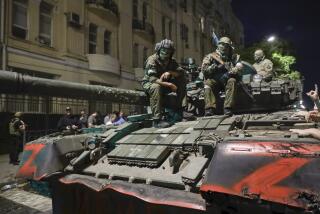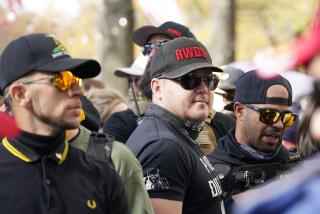Long, Careful Police Work Cracked Red Army Faction
- Share via
About all that is left of the Red Army Faction is the painful memory of more than 50 killings for a left-wing cause never clearly articulated and eventually abandoned by its own adherents.
Born in the violence of the 1960s student movement, the RAF died out a decade ago, depleted by deaths, imprisonment, lost idealism and reunification.
Also known as the Baader-Meinhof Gang, the RAF in its 1970s heyday bore many parallels to the suspected terrorist network that came together in Hamburg over the last few years and plotted the strikes against the United States.
RAF terrorists kidnapped businessmen and bankers, hijacked planes, blew up department stores and assassinated icons of the establishment.
But the RAF was a small, identifiable band of extremists focused on German targets. Tackling the shadowy international network suspected in the Sept. 11 attacks will be far more difficult, say those involved in defeating the RAF. Their advice to the United States: be patient.
“It was long, hard, careful police and intelligence work that prepared the final operations,” said Ulrich Wegener, who founded Germany’s elite GSG9 anti-terrorism squad. “We tracked the hard core of three or four people for about two years before we moved to capture them.”
Wegener, whose black beret and .357 Magnum service revolver are on display at the German History Museum in Bonn, said there are similarities between the perpetrators of the U.S. attacks and RAF members. Both groups stemmed from circles of educated but disgruntled idealists, often from prosperous families.
But those believed to have financed and instigated the Sept. 11 terror are likely far more committed to their cause, German experts say.
“The RAF was not willing to die for its ideals, although some did commit suicide,” Wegener said in an interview. “But the suicides were more a sign that they had given up. In the end, the RAF capitulated.”
The RAF was born as the June 2 Movement, named for the date in 1967 when German police shot to death a student protester, Benno Ohnesorg. Its founders were Andreas Baader, Ulrike Meinhof and Gudrun Ensslin, who were repeatedly arrested, tried and jailed--only to escape or be freed to satisfy the demands of allied kidnappers.
Meinhof killed herself in prison in 1976, after several hostage-takings failed to win her release.
The RAF’s bloodiest year was 1977, when bombings and assassinations killed a federal prosecutor and a prominent banker, among others, leading to the convictions of most high-profile RAF members.
On Sept. 5 that year, the remnants of the gang kidnapped industrialist Hanns-Martin Schleyer in an attempt to win release of their jailed comrades. Six weeks later, four Palestinians working for the RAF hijacked a planeload of German tourists leaving Majorca and began a five-day odyssey of terror in which a pilot was shot to death.
Wegener led the Oct. 17 commando storming of the hijacked Lufthansa plane in Mogadishu, Somalia, that freed all 91 hostages while killing three of the four hijackers. This prompted the suicides of Baader and two other RAF operatives in prison. A fourth inmate who survived knife wounds, Irmgard Moeller, later claimed that German security forces had killed her comrades and inflicted her injuries--a contention denied by officials.
Schleyer’s captors killed him a day after the Mogadishu raid.
The loss of the hard-core founders sent the rest of the RAF into hiding. Some emerged sporadically to carry out assassinations: a state economics minister in 1981, U.S. soldiers at Rhein-Main air base in 1985, Deutsche Bank chief Alfred Herrhausen in 1989.
One of the RAF’s last acts was in 1991, when the group claimed responsibility--as always, leaving its signature red star and Kalashnikov rifle emblem at the scene--for killing Detlev Rohwedder, head of the Treuhand agency, which privatized East German property after reunification.
“Terrorists had found shelter in East Germany with the help of the Stasi [state security]. After reunification, they lost their cover, as well as some of their meaning,” said Rolf Tophoven, a former GSG9 strategist who has written a book about the commando force. “They began arguing among themselves about their objectives. The cadres began to see this was a war they wouldn’t win. In the end, the RAF let itself die.”
It wasn’t until 1998 that the RAF announced that it had disbanded, but authorities had already concluded it had gone out of business.
“We’re still careful not to say that this is all over,” said Frauke Katrin Scheuten, a spokeswoman for the federal prosecutor’s office in Karlsruhe. She noted that the last recorded RAF attack was a 1993 bombing.
More to Read
Sign up for Essential California
The most important California stories and recommendations in your inbox every morning.
You may occasionally receive promotional content from the Los Angeles Times.










